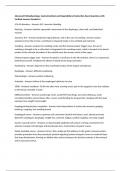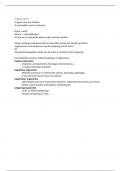Advanced Pathophysiology- Gastrointestinal and Hepatobiliary Dysfunction Exam Questions with
Verified Answers Graded A+
S/Sx GI disorders - Answers N/V, anorexia, bleeding
Retching - Answers rhythmic spasmodic movements of the diaphragm, chest wall, and abdominal
muscles
Anorexia, N/V - Answers protective-signal disease, and in the case of vomiting, remove noxious
substances from the GI tract, contribute to impaired intake or loss of fluids and nutrients
Vomiting - Answers involves the vomiting center and the chemoreceptor trigger zone, the act of
vomiting is thought to be a reflex that is integrated in the vomiting center, which is located in the dorsal
portion of the reticular formation of the medulla near the sensory nuclei of the vagus.
Chemoreceptor trigger zone - Answers located in a small area in the 4th ventricle, where is is exposed to
both blood and CSF. Mediates the effects of blood-borne drugs and toxins
Swallowing - Answers depends on the coordinated action of the tongue and pharynx.
Dysphagia - Answers difficulty swallowing
Odynophagia - Answers painful swallowing
Achalasia - Answers failure of the esophageal sphincter to relax
GERD - Answers heartburn- 30-60 min after meal, evening onset, pain in the epigastric area that radiates
to the throat, shoulder or back.
GERD prevention - Answers avoid large meals, avoid ETOH and drugs, eat meals sitting up, avoid
recumbent position several hours after a meal, avoid bending for long periods, sleeping with the head
elevated, lose weight if overweight
Esophageal diverticulum complaints - Answers food stops before it reaches the stomach, gurgling,
belching, coughing, foul-smelling breath
Esophageal cancer - Answers squamous cell carcinoma (alcohol and tobacco use), adenocarcinoma
(Barrett's esophagus), dysphagia, weight loss, anorexia, fatigue, painful coughing, not easily caught
Gastric mucosal barrier - Answers an impermeable epithelial cell surface covering, mechanisms for
selective transport of hydrogen and bicarbonate ions, charcteristics of gastric mucus
Water-insoluble mucus - Answers forms a thin, stable gel that adheres to the gastric mucosal surface,
provides protection from the proteolytic (protein digesting) actions of pepsin, forms an unstirred layer
that traps bicarbonate, forming an alkaline inter surface between the luminal contents of the stomach
and its mucosal surface.
, Water soluble mucus - Answers Washed from the mucosal surface, mixes with the luminal contents,
viscid nature makes it a lubricant that prevents mechanical damage to the mucosal surface
Helicobacter pylori - Answers colonize the mucus secreting cells of the stomach, produce enzymes and
toxins that have the capacity to interfere with the local protection of the gastric mucosa against acid
leading to ulcers, produce intense inflammation, elicit an immune response
H. Pylori dx - Answers C urea breath test using a radioactive carbon isotope, stool antigen test,
endoscopic biopsy for urease testing, blood tests to obtain serologic titers of H. pylori antibodies
Peptic ulcer - Answers ulcerative disorders that occur in the upper GI tract that are exposed to acid-
pepsin secretion. Spontaneous remissions and exacerbations are common
PUD causes - Answers H. pylori, ASA, age, Warfarin, Smoking
Peptic ulcer complications - Answers hemorrhage from bleeding from granulation tissue or from erosion
of an ulcer into an artery or vein, obstruction- caused by edema, spasm, or contraction of scar tissue and
interference with the free passage of gastric contents through the pylorus or adjacent areas, and
perforation from when the ulcer erodes through all the layers of the stomach or duodenum wall
Hematemesis - Answers blood in the vomiting, may be bright red or coffee ground
Melena - Answers blood in the stool, ranges in color from bright red to tarry black. May be occult
(hidden)
Pepcid ulcer treatment - Answers eradicate the cause and promote a permanent cure- eradicate H.
pylori, receiving ulcer symptoms, healing the ulcer crater (acid neutralizing, acid inhibiting drugs and
mucosal protective drugs, antacids, proton pump inhibitors
Risk factors for the development of stress ulcers - Answers large surface-area burns, trauma, sepsis,
ARDS, severe liver failure, major surgical procedures, Zollinger-Ellison syndrome
Risk factors for gastric CA - Answers genetic predisposition, carcinogenic factors in the diet, autoimmune
gastritis, gastric adenomas or polyps
Conditions causing altered intestinal function - Answers Irritable bowel disease, inflammatory bowel
disease, diverticulitis, appendicitis, alteration in bowel motility, malabsorption syndrome, cancer of the
colon and rectum
Infections of the intestine - Answers rotavirus (viral), C-diff or E-coli O157:H7 (bacterial), E. histolytica
(protozoal)
Irritable bowel disease - Answers perisitant or recurrent abdominal pain, altered bowel function,
flatulence or bloatedness, nausea and anorexia, constipation or diarrhea, anxiety or depression
Inflammatory bowel disease - Answers Crohn's and Ulcerative colitis







